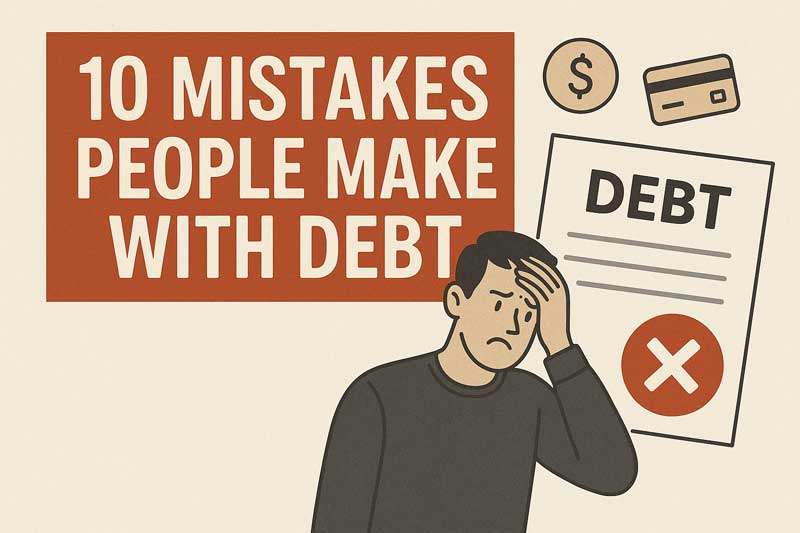
No one likes being in debt, and debt becomes increasingly stressful as balances rise and it gets harder and harder to make timely payments.
-
Ignoring debt and hoping for the best. Taking a head-in-the-sand approach to debt can cost you thousands or even tens of thousands of dollars over time and can put assets like your vehicle and bank accounts at risk. When you’re overwhelmed by debt, look at it head on. Gather information and make a plan right away.
-
Not knowing where your money is going. Too many people get caught in the cycle of juggling and playing catch-up and never identify the underlying problem. When you’re struggling with debt, your first step should always be to take stock of your income and expenses in great detail to see exactly where the problem lies and how significant your monthly shortfall is.
-
Guessing at what you can afford. Negotiating with creditors to reduce payments, skip a payment, or pay off your debt in a partial lump sum can be beneficial. But it can also be dangerous if you don’t do some hard math first. Remember that an agreement that sounds like a good deal may still be unaffordable for you, and could jeopardize other bills.
-
Not recognizing the ramifications of settling debt. When a creditor accepts partial payment in full settlement of a debt, you may get an ugly surprise in January–a 1099 for the portion of the debt they wrote off. In some situations, that’s a worthwhile trade-off. And, if you’re insolvent at the time the debt is settled there is a form you can file with your taxes to avoid being taxed on that “income.” But it’s important to know what to expect and factor it in when you’re making decisions.
-
Prioritizing based on creditor pressure. If you don’t have enough money to go around, it’s crucial to make reasoned decisions about your highest priorities. But when a creditor calls and dials up the pressure, it can be hard to resist. Never agree to a payment just to get a creditor off the phone–assess all of your obligations and determine what you can afford to pay based on what’s most important to you.
-
Sacrificing the future for short-term relief. One of the most common examples of this misstep is gutting retirement accounts to pay down unsecured debt. The long-term cost of that short-term relief can be significant, impacting your quality of life after you retire and even when you can retire. And, if you haven’t done some ruthless math, you could end up right back in debt.
-
Turning unsecured debt into secured debt. When you refinance your house or take out a home equity loan to pay off credit card debt, medical bills or other unsecured debt, your debt doesn’t decrease–you just turn low-risk debt into high-risk debt. When you secure that debt with a mortgage, a financial setback could mean losing your home, and you’ll have lost the ability to discharge that debt in bankruptcy unless you’re willing to give up your home.
-
Getting trapped in a cycle of high-interest debt. When you’re in a financial crunch, a payday loan or other short-term, high-interest solution may seem like the perfect stopgap measure. Unfortunately, those short-term solutions often turn out to be long-term. One study found that 80% of payday loan borrowers either rolled over their loans or borrowed again within 30 days.
-
Falling victim to financial rescue scams. Whether it’s a debt settlement company promising to settle your debts for a fraction of what you owe or a foreclosure rescue plan where the company buys your house but promises you can keep living in it, a solution that sounds too good to be true usually is. Thoroughly do your homework before you sign on.
-
Misunderstanding bankruptcy. Many people shy away from bankruptcy because of misconceptions. Unfortunately, that misinformation can lead to people struggling with debt for years before seeking a resolution. That delay may cost thousands or even tens of thousands of dollars in interest and late fees, or even mean the loss of a car or home.
For many people, bankruptcy can stop wage garnishment or auto repossession, halt lawsuits, and eliminate unsecured debt like credit card debt and medical bills. In some cases, Chapter 13 bankruptcy can help avoid foreclosure. And, a bankruptcy filer who discharges debts in Chapter 7 or Chapter 13 won’t get a 1099 and a big tax obligation when those debts are eliminated.
At Borowitz & Clark, we’ve helped tens of thousands of Californians resolve debt and move forward on a more solid financial footing. We know how important it is for you to have reliable information about your options when you’re struggling with debt. That’s why we offer free, no-obligation consultations to people in and around Los Angeles. To learn more, call us at 877-439-9717 or fill out our contact form.
